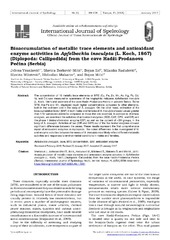Приказ основних података о документу
Bioaccumulation of metallic trace elements and antioxidant enzyme activities in Apfelbeckia insculpta (L. Koch, 1867) (Diplopoda: Callipodida) from the cave Hadži-Prodanova Pećina (Serbia)
| dc.creator | Vranković, Jelena | |
| dc.creator | Borković Mitić, Slavica | |
| dc.creator | Ilić, Bojan | |
| dc.creator | Radulović, Milanka | |
| dc.creator | Milošević, Slaviša | |
| dc.creator | Makarov, Slobodan | |
| dc.creator | Mitić, Bojan | |
| dc.date.accessioned | 2017-11-23T11:30:03Z | |
| dc.date.available | 2017-11-23T11:30:03Z | |
| dc.date.issued | 2017 | |
| dc.identifier.issn | 0392-6672 | |
| dc.identifier.uri | http://scholarcommons.usf.edu/ijs/vol46/iss1/12/ | |
| dc.identifier.uri | https://radar.ibiss.bg.ac.rs/handle/123456789/2606 | |
| dc.description.abstract | The concentration of 10 metallic trace elements or MTE (Cu, Fe, Zn, Mn, As, Hg, Pb, Cd, Ni, and Cr) was measured in specimens of the troglophilic millipede Apfelbeckia insculpta (L. Koch, 1867) and sediment of the cave Hadži-Prodanova Pećina in western Serbia. Some MTE, like Fe and Mn, displayed much higher concentrations compared to other elements, both in the sediment and in the body of A. insculpta. On the other hand, estimation of the bioaccumulation factor (BAF) in both males and females of A. insculpta showed values greater than 1 for xenobiotic elements compared to those that are essential. In addition to chemical analyses, we examined the activities of antioxidant enzymes (SOD, CAT, GPX, and GR) and the phase II biotransformation enzyme GST, as well as the content of –SH groups, in the body of A. insculpta. Activities of two (GR and GST) out of the five tested enzymes showed significant differences between the sexes. These results represent the first comprehensive report of antioxidant enzymes in myriapods. The noted differences in the investigated MTE and enzyme activities between the sexes of A. insculpta most likely reflect different metabolic activities and responses to environmental conditions in males and females. | en |
| dc.relation | info:eu-repo/grantAgreement/MESTD/Basic Research (BR or ON)/173025/RS// | |
| dc.relation | info:eu-repo/grantAgreement/MESTD/Basic Research (BR or ON)/173038/RS// | |
| dc.relation | info:eu-repo/grantAgreement/MESTD/Basic Research (BR or ON)/173041/RS// | |
| dc.rights | openAccess | |
| dc.rights.uri | https://creativecommons.org/licenses/by-nc/4.0/ | |
| dc.source | International Journal of Speleology | |
| dc.subject | Antioxidant enzyme | |
| dc.subject | Apfelbeckia insculpta | |
| dc.subject | BAF | |
| dc.subject | Cave | |
| dc.subject | MTE concentration | |
| dc.title | Bioaccumulation of metallic trace elements and antioxidant enzyme activities in Apfelbeckia insculpta (L. Koch, 1867) (Diplopoda: Callipodida) from the cave Hadži-Prodanova Pećina (Serbia) | en |
| dc.type | article | |
| dc.rights.license | BY-NC | |
| dcterms.abstract | Радуловић, Миланка; Борковић-Митић, Славица; Илић, Бојан; Милошевић, Славиша; Макаров, Слободан; Митић, Бојан; Вранковић, Јелена; | |
| dc.rights.holder | © 2017, Societa Speleologica Italiana | |
| dc.citation.issue | 1 | |
| dc.citation.volume | 46 | |
| dc.description.other | International Journal of Speleology (2017), 46(1): 99-108 | |
| dc.identifier.doi | 10.5038/1827-806X.46.1.1981 | |
| dc.identifier.scopus | 2-s2.0-85014027651 | |
| dc.identifier.wos | 000395945600009 | |
| dc.citation.apa | Vranković, J., Borković-Mitić, S., Ilić, B., Radulović, M., Milošević, S., Makarov, S., & Mitić, B. (2017). Bioaccumulation of metallic trace elements and antioxidant enzyme activities in Apfelbeckia insculpta (L. Koch, 1867) (Diplopoda: Callipodida) from the cave Hadži-Prodanova Pećina (Serbia). International Journal of Speleology, 46(1), 99–108. | |
| dc.citation.vancouver | Vranković J, Borković-Mitić S, Ilić B, Radulović M, Milošević S, Makarov S, Mitić B. Bioaccumulation of metallic trace elements and antioxidant enzyme activities in Apfelbeckia insculpta (L. Koch, 1867) (Diplopoda: Callipodida) from the cave Hadži-Prodanova Pećina (Serbia). Int J Speleol. 2017;46(1):99–108. | |
| dc.citation.spage | 99 | |
| dc.citation.epage | 108 | |
| dc.type.version | publishedVersion | en |
| dc.identifier.fulltext | https://radar.ibiss.bg.ac.rs//bitstream/id/3411/IntJSpeleol_2017_46_1_99-108.pdf | |
| dc.citation.rank | M22 |

